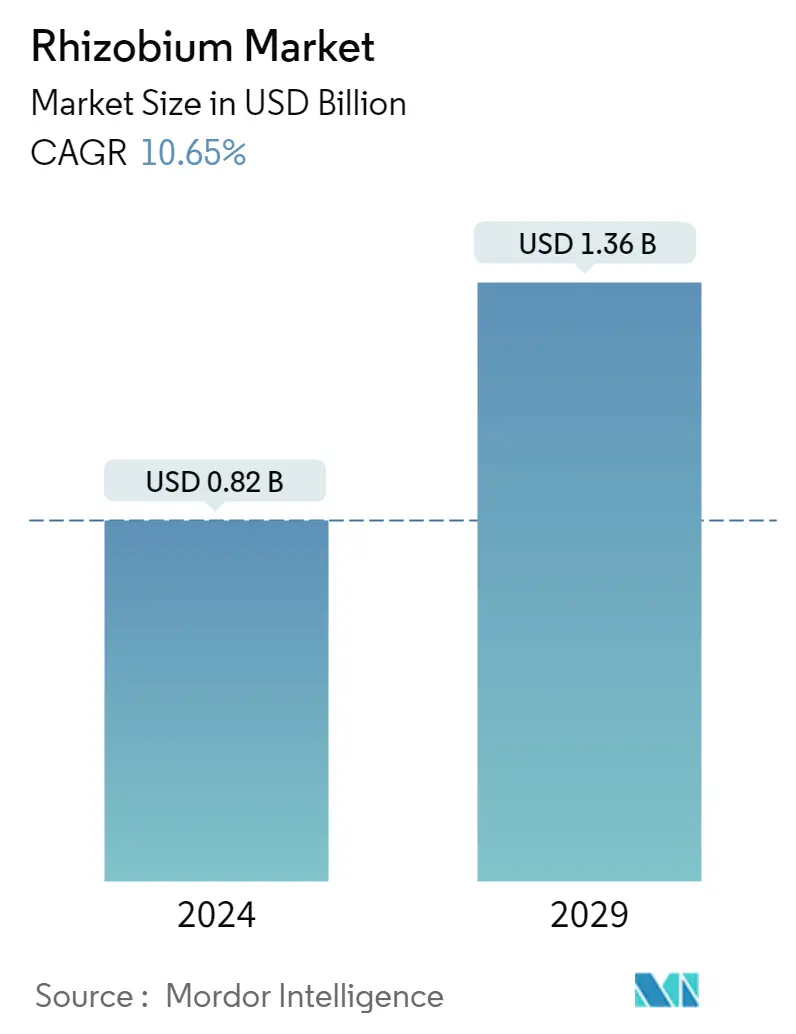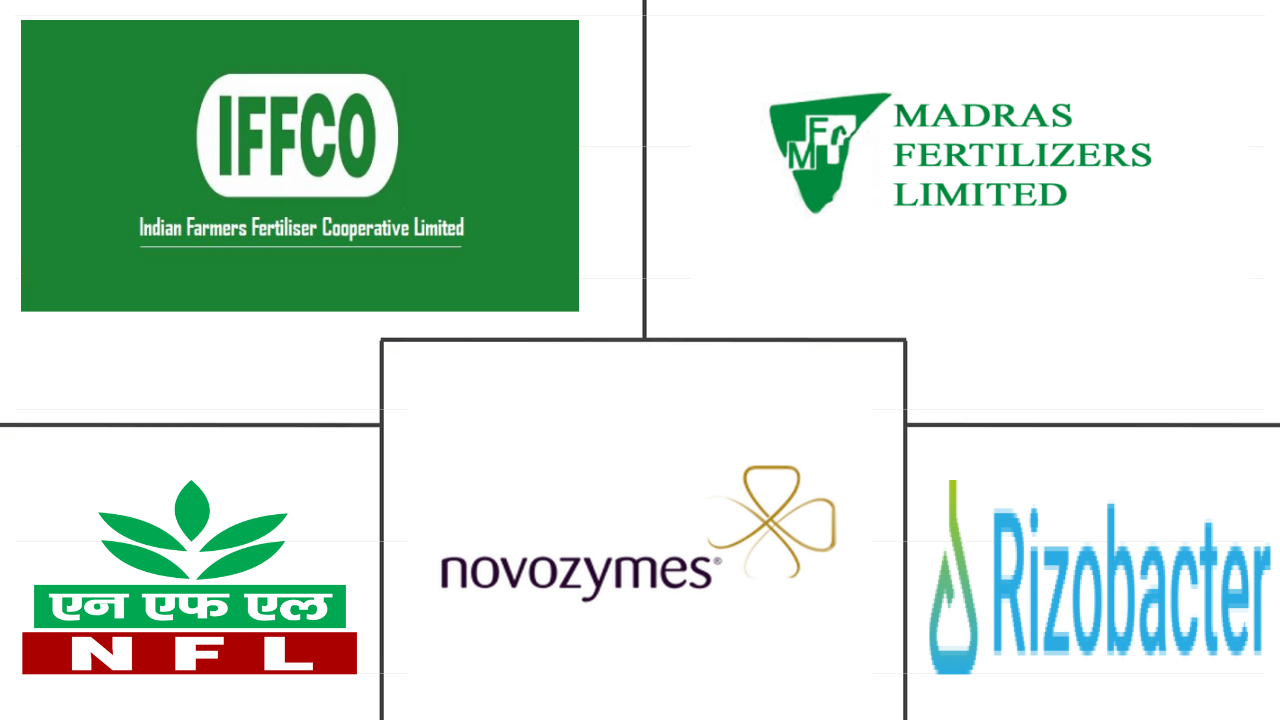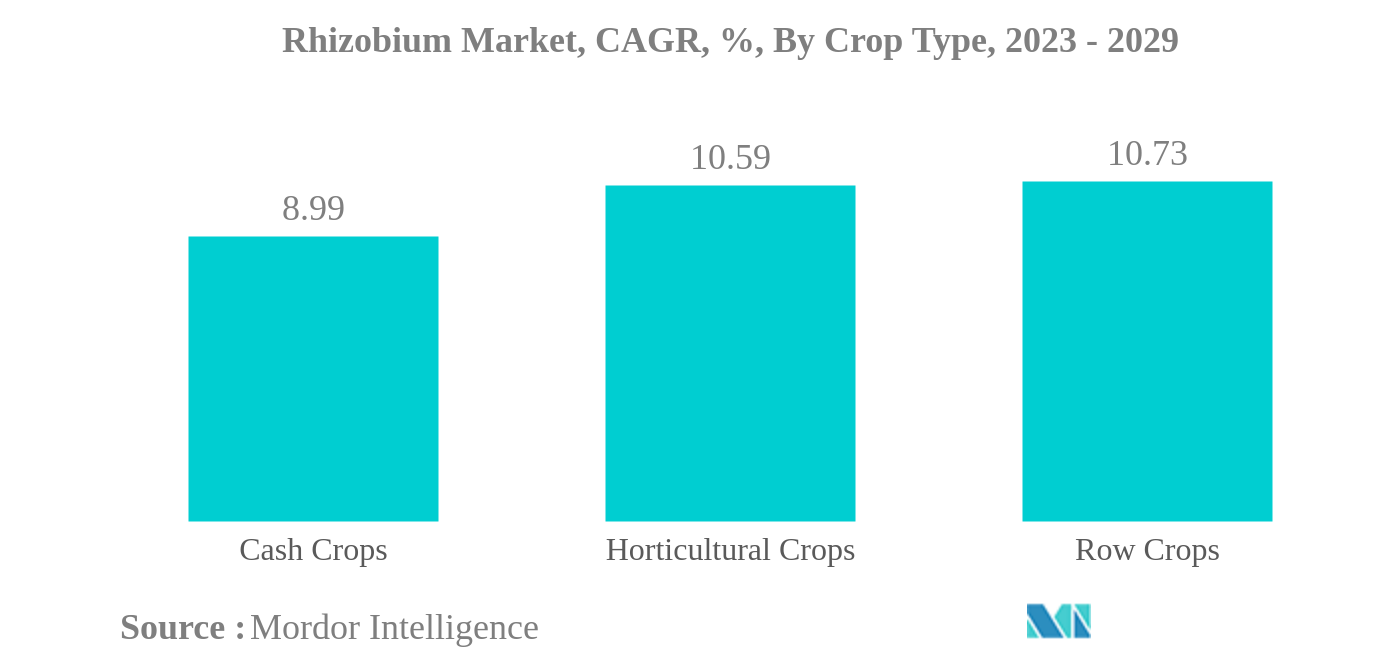Market Size of rhizobium Industry

|
|
Study Period | 2017 - 2029 |
|
|
Market Size (2024) | USD 0.82 Billion |
|
|
Market Size (2029) | USD 1.36 Billion |
|
|
Largest Share by Crop Type | Row Crops |
|
|
CAGR (2024 - 2029) | 10.65 % |
|
|
Largest Share by Region | North America |
Major Players |
||

|
||
|
*Disclaimer: Major Players sorted in no particular order |
Rhizobium Biofertilizers Market Analysis
The Rhizobium Market size is estimated at USD 0.82 billion in 2024, and is expected to reach USD 1.36 billion by 2029, growing at a CAGR of 10.65% during the forecast period (2024-2029).
- Row Crops is the Largest Crop Type. The interaction between rhizobia and legume roots results in the formation of a highly regulated process converts atmospheric nitrogen into an assimilable plant nutrient.
- Row Crops is the Fastest-growing Crop Type. Barley, maize, wheat, rapeseed, rye, sunflower, soybean, and rice crops formed globally. North America and Europe regions row crop's consumption dominating the market.
- North America is the Largest Region. The increased organic cultivation of row crops in the United states and Canada resulted in an increase in the use of rhizobia-based biofertilizers in the region.
- United States is the Largest Country. Corn, soybeans, rice, wheat, and alfalfa are produced in the country and the organic area under cultivation of field crops has expanded, increased by 27.4% from 2017 to 2022.
This section covers the major market trends shaping the Rhizobium Market according to our research experts:
Row Crops is the largest Crop Type
- The specific interaction between rhizobia and legume roots results in the formation of a highly regulated process termed modulation, which converts atmospheric nitrogen into an assimilable plant nutrient. This ability provides the basis for the use of bacterial inoculants in field crop production. Row crops dominated the mycorrhiza market in 2022, accounting for around 69.7% of market value. Globally, the most important row crops are barley, maize, wheat, rapeseed, rye, sunflower, soybean, and rice.
- The market for rhizobium-based biofertilizers in horticultural crops is expected to be worth USD 137.2 million, with 4.9 thousand metric tons used in 2022. Rhizobium strains colonize the roots of tomato and pepper plants to encourage growth at various stages of production, increasing seedling and fruit yield and quality. It is also utilized in greenhouse culture, such as tomato and capsicum farming, as well as other horticultural fruit growing.
- Coffee, tea, cocoa, cotton, sugarcane, rapeseed, sunflower, and tobacco are some of the major cash crops grown globally. Cash crops accounted for USD 68.7 million in the market value of rhizobium-based biofertilizers in 2022. North America dominated the market for cash crops and accounted for about USD 52.2 million in 2022.
- Rhizobium inoculation can provide plant nitrogen requirements while decreasing the demand for inorganic nitrogen fertilizer. Effective rhizobium inoculation can deliver up to 50-70% of the total nitrogen required to boost yields. Rhizobium also generates vitamins, amino acids, siderophores, auxins, and nitrogen fixation.
- Owing to the above-mentioned characteristics and the increase in the application of rhizobium-based fertilizers, the market is anticipated to grow during the forecast period.

Rhizobium Biofertilizers Industry Segmentation
Cash Crops, Horticultural Crops, Row Crops are covered as segments by Crop Type. Africa, Asia-Pacific, Europe, Middle East, North America, South America are covered as segments by Region.
| Crop Type | |
| Cash Crops | |
| Horticultural Crops | |
| Row Crops |
| Region | |||||||||||||
| |||||||||||||
| |||||||||||||
| |||||||||||||
| |||||||||||||
| |||||||||||||
|
Rhizobium Market Size Summary
The rhizobium biofertilizer market is poised for significant growth, driven by its critical role in enhancing nitrogen availability for crops through its symbiotic relationship with leguminous plants. This market is characterized by the increasing adoption of organic farming practices, particularly in North America and Europe, where row crops such as barley, maize, and soybean are predominant. The ability of rhizobium to convert atmospheric nitrogen into a form usable by plants makes it a valuable component in sustainable agriculture, reducing the reliance on inorganic fertilizers. The market is further bolstered by the expanding cultivation of leguminous crops, which are essential for nitrogen fixation, and the growing demand for environmentally friendly agricultural inputs.
In addition to its application in row crops, rhizobium biofertilizers are gaining traction in horticultural and cash crop sectors, with notable usage in crops like tomatoes, peppers, and cotton. The market is fragmented, with key players such as Indian Farmers Fertiliser Cooperative Limited and Novozymes leading the charge in innovation and product development. Strategic partnerships and new product launches, such as the introduction of granular inoculants, are enhancing the efficacy and adoption of rhizobium-based solutions. As the global focus shifts towards sustainable agricultural practices, the rhizobium biofertilizer market is expected to experience robust growth, supported by technological advancements and increasing awareness of the benefits of biological nitrogen fixation.
Rhizobium Market Size - Table of Contents
-
1. MARKET SEGMENTATION
-
1.1 Crop Type
-
1.1.1 Cash Crops
-
1.1.2 Horticultural Crops
-
1.1.3 Row Crops
-
-
1.2 Region
-
1.2.1 Africa
-
1.2.1.1 By Country
-
1.2.1.1.1 Egypt
-
1.2.1.1.2 Nigeria
-
1.2.1.1.3 South Africa
-
1.2.1.1.4 Rest of Africa
-
-
-
1.2.2 Asia-Pacific
-
1.2.2.1 By Country
-
1.2.2.1.1 Australia
-
1.2.2.1.2 China
-
1.2.2.1.3 India
-
1.2.2.1.4 Indonesia
-
1.2.2.1.5 Japan
-
1.2.2.1.6 Philippines
-
1.2.2.1.7 Thailand
-
1.2.2.1.8 Vietnam
-
1.2.2.1.9 Rest of Asia-Pacific
-
-
-
1.2.3 Europe
-
1.2.3.1 By Country
-
1.2.3.1.1 France
-
1.2.3.1.2 Germany
-
1.2.3.1.3 Italy
-
1.2.3.1.4 Netherlands
-
1.2.3.1.5 Russia
-
1.2.3.1.6 Spain
-
1.2.3.1.7 Turkey
-
1.2.3.1.8 United Kingdom
-
1.2.3.1.9 Rest of Europe
-
-
-
1.2.4 Middle East
-
1.2.4.1 By Country
-
1.2.4.1.1 Iran
-
1.2.4.1.2 Saudi Arabia
-
1.2.4.1.3 Rest of Middle East
-
-
-
1.2.5 North America
-
1.2.5.1 By Country
-
1.2.5.1.1 Canada
-
1.2.5.1.2 Mexico
-
1.2.5.1.3 United States
-
1.2.5.1.4 Rest of North America
-
-
-
1.2.6 South America
-
1.2.6.1 By Country
-
1.2.6.1.1 Argentina
-
1.2.6.1.2 Brazil
-
1.2.6.1.3 Rest of South America
-
-
-
-
Rhizobium Market Size FAQs
How big is the Rhizobium Market?
The Rhizobium Market size is expected to reach USD 0.82 billion in 2024 and grow at a CAGR of 10.65% to reach USD 1.36 billion by 2029.
What is the current Rhizobium Market size?
In 2024, the Rhizobium Market size is expected to reach USD 0.82 billion.

